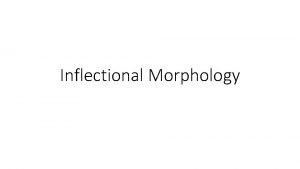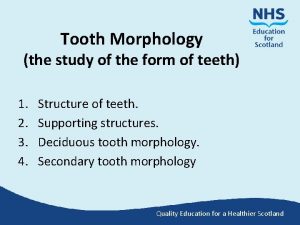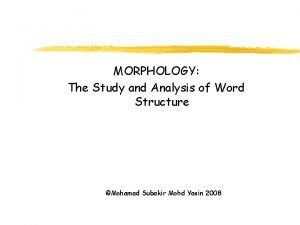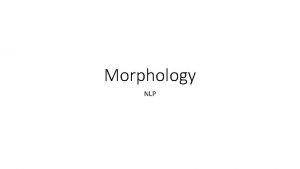III MORPHOLOGY III Morphology 1 Morphology The study




- Slides: 4

III. MORPHOLOGY

III. Morphology 1. Morphology The study of the internal structure of words and the rules by which words are formed. 1. 1 Open classes and closed classes Open classes: word categories into which we can regularly add new words. In English, nouns, verbs, adjectives and adverbs Closed classes: The other syntactic classes into which it is not easy for a new article to be added into. In English, pronouns prepositions, articles 2. Morphemes—the minimal units of meaning free morphemes: morphemes that can constitute words by themselves bound morphemes: morphemes that cannot occur alone unaccepted thank steal bottles interested finger incorrect teacher An affix: a bound morpheme that occurs together with other morphemes. A prefix is an affix that position is before other morphemes. A suffix is an affix which occurs after other morphemes. (un- in- -ed -s -er)

A root is the base form of a word that cannot be further analyzed without total loss of identity. In other words, a “root” is that part of a word left when all the affixes are removed. A stem is any morpheme or combination of morphemes to which an affix can be added. 3. Derivational and inflectional morphemes When a derivational morpheme is added to other morphemes or words a new word is derived, or formed. An inflectional morpheme is added to morphemes or words but does not change their syntactic category. I disliked his often gossiping about others’ secrets. Derivational morphemes: dis-, Inflectional morphemes: -ed, -ing, -s, -‘s, -s 4. Morphological rules of word formation The ways words are formed are called morphological rules. These rules determine how morphemes combine to form words.

Some of the morphological rules can be used quite freely to form new words We call them productive morphological rules. 5. Compounds compound is another way to produce words, that is, to string together words. a) When the two words are in the same grammatical category, the compound will be in this category. b) When the two words fall into different categories, the class of the second or final word will be the grammatical category of the compound word, with the exception of compounds with a preposition. c) It is more often than not that compounds have different stress patterns from the non-compound word sequence. d) The meaning of a compound is not always the sum of the meanings of its parts. Books for further Reading: 1. Matthews, P. H. Morphology Beijing: FLT & R Press. 2000.







